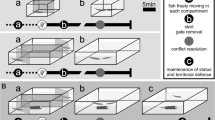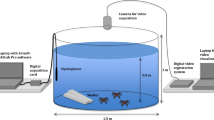Summary
-
1.
The electrical interactions of a pair of Gymnotus carapo of known dominance relationship were studied in a large semi-natural aquarium while resting during the daytime (Fig. 1).
-
2.
Synchronisations of the two discharge frequencies were found to occur predominantly in bouts of 15–20 consecutive intervals although very close frequencies with beat periods lasting more than 100 intervals were recorded.
-
3.
The delay of a fish's pulses with respect to those of its partner during a synchronisation showed specific dominance-related tendencies indicating that the dominant fish places its discharges in the period of maximum electroreceptive sensitivity of the submissive animal (Figs. 2, 3, and 4). Such a synchronisation effectively protects the first fish from the jamming effect of its partner's pulses.
-
4.
The analysis of 4-h recordings demonstrated the existence of clear jamming-avoidance manoeuvres in Gymnotus. Examination of these responses showed that when jamming-avoidance frequency increases occurred at near discharge coincidence, it was the lower frequency fish which readjusted its frequency (Fig. 5)
-
5.
Interactions at close discharge frequency (Figs. 6, 7, and 8) show that frequency following takes place in certain situations and a struggle for ‘frequency dominance’ is seen which, it is suggested, is the best strategy for the preservation of optimal electrolocation.
-
6.
A model is proposed (Fig. 9) to account for the different sensitivity of Gymnotus to foreign pulses sweeping through its own discharge in either the time-positive (lower frequency partner) or time-negative (higher frequency partner) directions. The model is based on the previous finding of a phaselocked attenuation of electroperceptive information in this species.
-
7.
Whether or not the jamming avoidance in Gymnotus is related to social communication remains an open question. Efficient jamming avoidance requires the determination of the sign and magnitude of the frequency difference between the interacting fish. This would also communicate information related to social dominance, previously shown to correlate well to overall discharge frequency. The present results indicate that the dominant fish was in the more favourable position, as far as efficient electrolocation is concerned, for most of the time.
Similar content being viewed by others
References
Bastian, J.: Frequency response characteristics of electroreceptors in weakly electric fish (Gymnotoidei) with a pulse discharge. J. comp. Physiol. 112, 165–180 (1976)
Black-Cleworth, P.: The role of electrical discharges in the non-reproductive social behaviour of Gymnotus carapo L. (Gymnotidae, Pisces). Anim. Behav. Monogr. 31, 1–77 (1970)
Box, H.O., Westby, G.W.M.: Behaviour of electric fish, (Gymnotus carapo) in a group membership experiment. Psychon. Sci. 21, 27–28 (1970)
Bullock, T.H., Behrend, K., Heiligenberg, W.: Comparison of jamming avoidance response in gymnotoid and gymnarchid electric fish: A case of convergent evolution of behaviour and its sensory basis. J. comp. Physiol. 103, 97–121 (1975)
Heiligenberg, W.: Electrolocation of objects in the electric fish Eigenmannia. J. comp. Physiol. 87, 137–164 (1973)
Heiligenberg, W.: Electrolocation and jamming avoidance in a Hypopygus, an electric fish with pulse-type discharges. J. comp. Physiol. 91, 233–240 (1974)
Heiligenberg, W.: Electrolocation and jamming avoidance in the electric fish Gymnarchus niloticus. J. comp. Physiol. 103, 55–67 (1975)
Heiligenberg, W.: Electrolocation and jamming avoidance in the mormyrid fish Brienomyrus. J. comp. Physiol. 109, 357–372 (1976)
Scheich, H., Gottschalk, B., Nickel, B.: The jamming-avoidance response in Rhamphichthys rostratus: An alternative principle of time domain analysis in electric fish. Exp. Brain Res. 28, 229–233 (1977)
Schlegel, P.: Electroreceptive single units in the mesencephalic magnocellular nucleus of the weakly electric fish Gymnotus carapo. Exp. Brain Res. 29, 201–218 (1977)
Szabo, T., Fessard, A.: Physiology of electroreceptors. In: Handbook of sensory physiology, Vol. 3. Fessard, A. (ed.), pp. 59–124. Berlin, Heidelberg, New York: Springer 1974
Valone, J.A.: Electrical emissions in Gymnotus carapo and their relation to social behaviour. Behaviour 37, 1–14 (1970)
Westby, G.W.M.: Assessment of the signal value of certain discharge patterns in the electric fish, Gymnotus carapo, by means of playback. J. comp. Physiol. 92, 327–341 (1974)
Westby, G.W.M.: Comparative studies of the aggressive behaviour of two gymnotid fish (Gymnotus carapo and Hypopomus artedi). Anim. Behav. 23, 192–213 (1975a)
Westby, G.W.M.: Further analysis of the individual discharge characteristics predicting social dominance in the electric fish Gymnotus carapo. Anim. Behav. 23, 249–260 (1975b)
Westby, G.W.M.: Has the latency-dependent response of Gymnotus carapo to discharge triggered stimuli a bearing on electric fish communication? J. comp. Physiol. 96, 307–341 (1975c)
Westby, G.W.M., Box, H.O.: Prediction of dominance in social groups of the electric fish, Gymnotus carapo. Psychon. Sci. 21, 181–183 (1970)
Zipser, B., Bennett, M.V.L.: Interaction of electrosensory and electromoter signals in the lateral line lobe of a mormyrid fish. J. Neurophysiol. 39, 713–721 (1976)
Author information
Authors and Affiliations
Rights and permissions
About this article
Cite this article
Max Westby, G.W. Electrical communication and jamming avoidance betwen resting Gymnotus carapo . Behav Ecol Sociobiol 4, 381–393 (1979). https://doi.org/10.1007/BF00303244
Received:
Issue Date:
DOI: https://doi.org/10.1007/BF00303244




